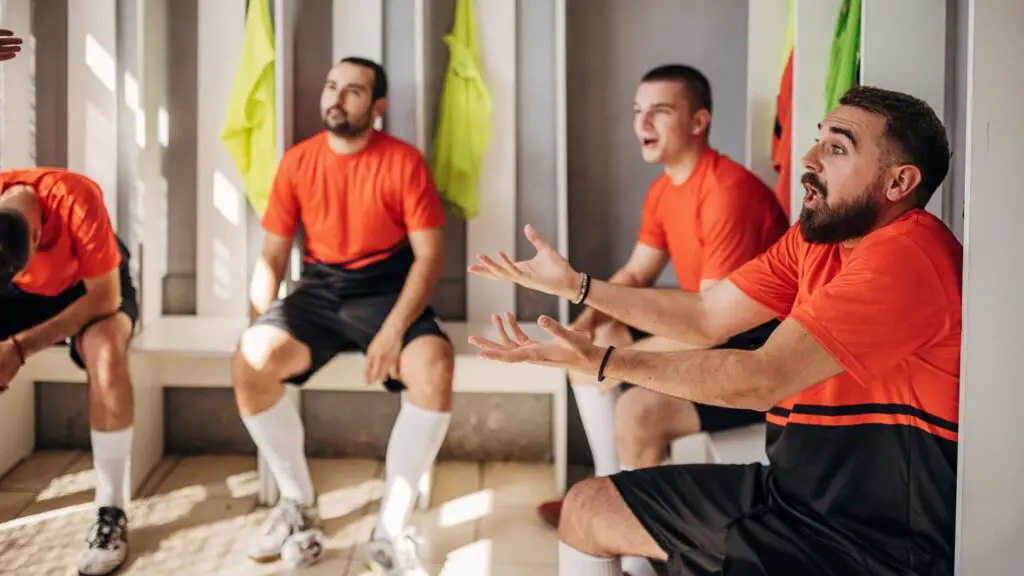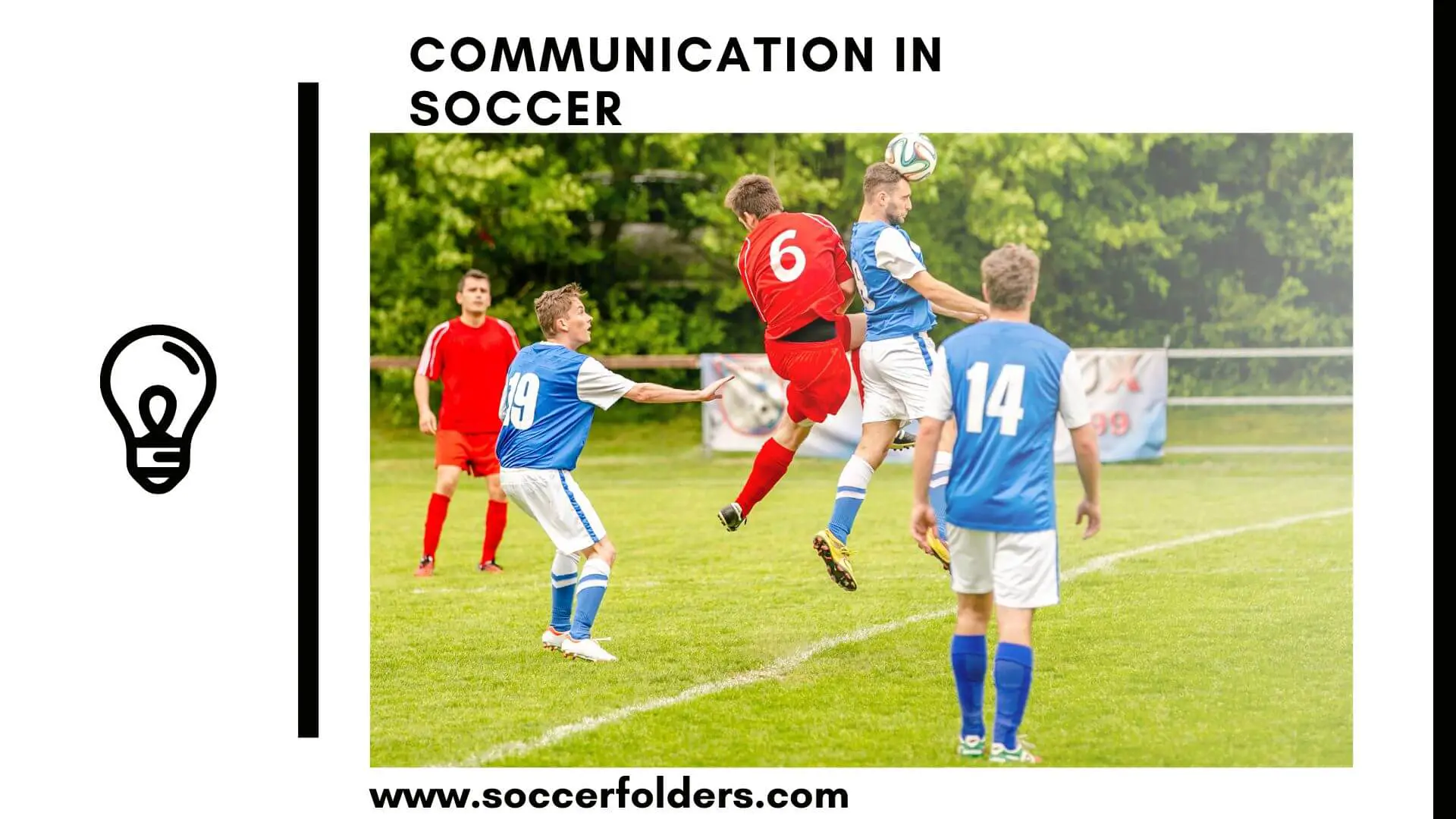Soccer, also known as football in many countries, is a sport that brings people together from all over the world. As with any team sport, communication is a crucial component of soccer.
A soccer team cannot function effectively without proper communication, and winning matches becomes more challenging.
In this blog post, we will explore the importance of communication in soccer and how it can make or break a team’s success.
Let’s get started.
Quick Navigation
- What is Communication in Soccer?
- Importance of Body Language in Soccer Communication
- The Role of Team Captains in Facilitating Communication among Players
- Strategies for effective communication during set pieces (e.g. corners, free kicks)
- How communication varies between different positions on the soccer field
- Examples of famous Soccer Teams with Exceptional Communication
- How communication can help players develop their skills and learn from each other
- Differences in communication between youth and professional soccer teams
-
Importance of Communication in Soccer: FAQ
- How do Soccer Players Communicate?
- Does Soccer Require Communication?
- In what language do Soccer Players Communicate?
- How do Soccer Teams Deal with language Barriers?
- How can you Improve Communication on a Soccer Field?
- What is an Example of Communication Play?
- How do Soccer Players Communicate with Refs?
- Final Word
What is Communication in Soccer?
Communication in soccer is the exchange of information between players, coaches, and other team members. It involves verbal and non-verbal communication, such as body language and gestures.
Communication is essential in soccer because it helps players coordinate their movements, understand their roles, and make quick decisions on the field. It allows players to anticipate each other’s actions and respond appropriately, leading to successful plays and ultimately, victories.
1. Importance of Feedback

One of the most critical aspects of communication in soccer is the ability to give and receive feedback.
Soccer is a fast-paced game, and players need to be able to adapt quickly to changing situations.
When players receive feedback from their coaches or teammates, they can adjust their actions accordingly, leading to better performance on the field.
Additionally, feedback helps players build trust and respect among teammates, which is essential for a successful team dynamic.
2. Leadership and Communication in Soccer

Another important aspect of communication in soccer is leadership.
In soccer, the captain is typically the player who leads the team on the field.
However, every player has a role in leading the team, whether it’s through verbal communication or leading by example.
For example, during the 2022 final World Cup game between France and Argentina, France was losing 0-1 at half-time. Mbappe decided to give a speech in the dressing room to motivate his teammates.
In the second half, France gave an outstanding performance…
So, when players communicate effectively and take charge when necessary, they can motivate their teammates and create a positive team dynamic.
3. Communication off the Field
Communication in soccer also extends beyond the field. It includes pre-match preparation, post-match analysis, and team meetings.
During pre-match preparation, coaches and players discuss strategies, game plans, and tactics.
Effective communication ensures everyone is on the same page and understands their roles and responsibilities.
The post-match analysis involves discussing the team’s performance, identifying areas for improvement, and celebrating successes. These discussions are essential for team growth and development.
One of the most significant benefits of effective communication in soccer is improved team morale.
When players communicate well, they feel more connected to their teammates and the game.
They feel supported and motivated to perform at their best.
==>>You can also read my full article about the motivation for soccer players here
Additionally, effective communication can help prevent misunderstandings, conflicts, and arguments, leading to a more positive team atmosphere.
Importance of Body Language in Soccer Communication
Body language plays a critical role in soccer communication as it helps players convey their intentions and emotions to their teammates and opponents.
Effective body language can communicate confidence, assertiveness, and teamwork, while poor body language can convey a lack of interest, lack of confidence, or even dissent.
For example, a player may use their body language to indicate where they want their teammate to pass the ball or to signal that they are open for a pass.
Similarly, a player’s body language can help them deceive their opponent and create space on the field.
Overall, body language is a vital component of soccer communication, and players who are aware of their body language and pay attention to their opponent’s body language can gain a competitive advantage on the field.
The Role of Team Captains in Facilitating Communication among Players
Team captains play a crucial role in facilitating communication among soccer players.
Captains are typically chosen for their leadership skills, and one of their key responsibilities is to ensure that their team communicates effectively on and off the field.
Captains can act as a liaison between players and coaches, helping to convey feedback and instructions clearly and concisely.
They can also help build team morale by encouraging positive communication and resolving conflicts between players.
Additionally, captains can help guide less experienced players by providing advice and support during games and practices.
Strategies for effective communication during set pieces (e.g. corners, free kicks)
Set pieces, such as corners and free kicks, provide opportunities for soccer teams to score goals and win games.
Effective communication during these set pieces is crucial for maximizing these opportunities.
One strategy is to designate specific players to be responsible for certain areas of the field, such as the near post, far post, or penalty spot.
These players can communicate with each other to ensure they are in the correct positions and ready to attack the ball when it is played.
Another strategy is to use non-verbal communication, such as hand signals or pre-determined movements, to signal to teammates where the ball should be played.
Effective communication during set pieces requires players to be aware of their surroundings, communicate clearly and concisely, and work together as a team to create scoring opportunities.
How communication varies between different positions on the soccer field
Communication varies between different positions on the soccer field due to the unique responsibilities and challenges that each position presents.
For example, defenders need to communicate with each other to ensure that they are marking the correct players and covering the appropriate areas of the field.
They also need to communicate with their goalkeeper to coordinate defensive strategies and clear the ball out of danger.
Midfielders, on the other hand, need to communicate with both the defense and the offense to ensure that the team maintains possession of the ball and creates scoring opportunities.
Forwards need to communicate with their teammates to coordinate attacks and make runs into open space.
In general, effective communication between players in different positions requires a deep understanding of the game and the ability to quickly adapt to changing situations on the field.
Good communication can help teams maximize their strengths and minimize their weaknesses, leading to better performance and more victories.
Examples of famous Soccer Teams with Exceptional Communication
There have been many famous soccer teams throughout history with exceptional communication, which has been a key factor in their success on the field.
One such team is FC Barcelona, which is known for its “tiki-taka” style of play that emphasizes quick passing and constant movement.
This style of play requires players to communicate effectively with each other to maintain possession of the ball and create scoring opportunities.
Another team with exceptional communication is the Spanish national team, which won the 2010 World Cup using a similar style of play.
The team’s players were able to communicate seamlessly with each other, thanks in part to the fact that many of them played for the same club team, FC Barcelona.
Finally, the 1970 Brazilian national team is often cited as one of the greatest teams in soccer history, thanks in large part to their exceptional communication and teamwork.
How communication can help players develop their skills and learn from each other
Communication plays a crucial role in helping soccer players develop their skills and learn from each other.
By communicating effectively, players can provide feedback, offer constructive criticism, and share knowledge and experience.
For example, a more experienced player can advise a less experienced player on how to improve their technique or decision-making skills.
Effective communication can also help players stay motivated and focused, as they can encourage each other and provide emotional support during tough games or challenging training sessions.
Overall, communication is a powerful tool that can help players develop their skills and become better soccer players.
Differences in communication between youth and professional soccer teams
There are significant differences in communication between youth and professional soccer teams.
In youth soccer, communication tends to be more directive and instructional, as coaches often play a more prominent role in guiding players on the field.

Youth players are still learning the game and developing their skills, so communication from coaches and older players is crucial in helping them understand the game and improve their performance.
In professional soccer, communication is more collaborative and fluid, with players taking a more active role in directing play and making decisions on the field.
Pro players have more experience and knowledge of the game, so they are better equipped to communicate with each other and adapt to changing situations during a match.
Additionally, communication in professional soccer tends to be more nuanced and subtle, with players using nonverbal cues and body language to signal their intentions and coordinate with teammates.
Importance of Communication in Soccer: FAQ
How do Soccer Players Communicate?
Soccer players communicate using both verbal and non-verbal methods. Verbal communication involves players calling out to each other on the field, using specific words or phrases to convey information such as position, direction, and strategy. Non-verbal communication in soccer involves the use of body language, hand gestures, and facial expressions to communicate with teammates. This type of communication is especially important in situations where verbal communication may not be possible due to the noise of the crowd or the distance between players on the field.
Does Soccer Require Communication?
Yes, soccer requires communication for players to effectively coordinate their movements, understand their roles, and make quick decisions on the field. Verbal and non-verbal communication is used among players, coaches, and other team members to convey important information such as position, direction, and strategy. Beyond the field, communication extends to pre-match preparation, post-match analysis, and team meetings, where strategies, game plans, and tactics are discussed.
In what language do Soccer Players Communicate?
Soccer players communicate in various languages, depending on the country, team, and individual player’s background. In international competitions, players may need to communicate with teammates who speak different languages. In such cases, a common language such as English may be used for communication. However, players may also use their native languages or a combination of languages to communicate with each other. Some teams may also have official languages, such as Spanish or French, that are used for communication during games and practices.
How do Soccer Teams Deal with language Barriers?
Soccer teams use various strategies to deal with language barriers among players. One common approach is to use a common language, such as English, for communication during games and practices. Teams may also hire interpreters or translators to assist with communication between players who speak different languages. Coaches may also provide language lessons or encourage players to learn each other’s languages to facilitate communication. In some cases, teams may recruit players who are fluent in multiple languages to help bridge the communication gap.
How can you Improve Communication on a Soccer Field?
Improving communication on a soccer field involves various strategies, including:
- Team-building exercises: Team-building exercises can help players build trust, improve communication, and develop better working relationships with each other. Such exercises can range from icebreakers and trust-building activities to team-building workshops.
- Clear and concise language: Using clear and concise language is essential for effective communication on the soccer field. Players should use specific words or phrases to convey information such as position, direction, and strategy.
- Non-verbal communication: Non-verbal communication, such as body language, hand gestures, and facial expressions, can also be used to convey information on the soccer field. Players should pay attention to their body language and be aware of the signals they are sending to their teammates.
- Technology in soccer communication: Technology, such as communication devices and software, can also be used to improve communication on the soccer field. For example, teams can use headsets to allow players to communicate with each other during games and practices.
What is an Example of Communication Play?
An example of communication play in soccer is the “give and go” or “one-two” play. This play involves two players communicating with each other through quick passes and movements to outmanoeuvre the opposing team’s defense. Player A passes the ball to Player B and then quickly moves into space to receive the ball back from Player B, who has moved into a new position. This quick exchange of passes and movements requires effective communication between the two players involved. The “give and go” play is an example of how communication on the soccer field can lead to successful plays and ultimately, victories for the team.
How do Soccer Players Communicate with Refs?
Soccer players communicate with referees through a combination of verbal and non-verbal cues. Players may approach the referee to ask questions or express their opinions about a call, but they must do so in a respectful manner. Body language can also be used to convey information to the referee. For example, a player may hold up their hands to indicate that they did not commit a foul or point to a particular area of the field to indicate where a ball went out of bounds.
Final Word
Effective communication is crucial for success in soccer. It allows players to coordinate their movements, understands their roles, and make quick decisions on the field.
It also helps build trust, respect, and positive team morale.
You can also read game intelligence in soccer.

